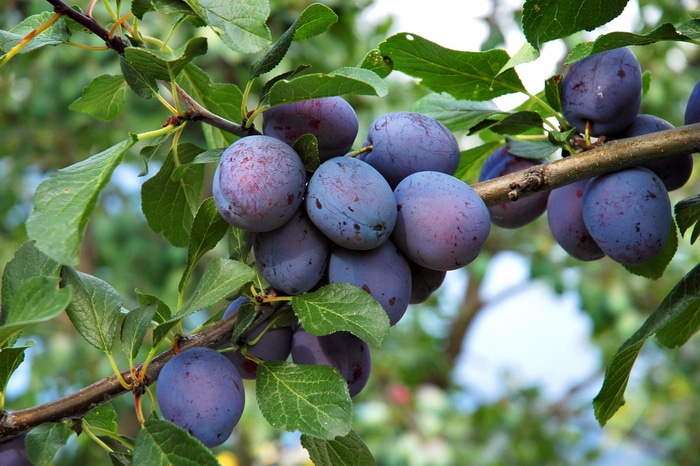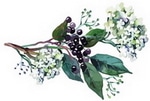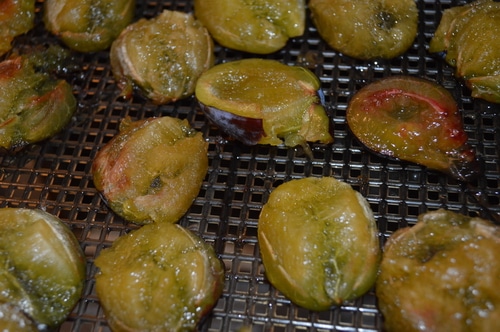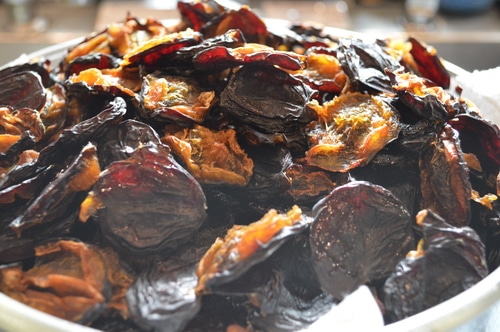There are many different varieties of plums and all do well dehydrated. Dried prunes are made from prune plums, also known as Italian plums, and are slightly softer when dried compared to other plum varieties.
How to dry prune plums
Dried prunes are made from plums. However, not all dried plums are prunes. Only Italian prune plums, the medium sized deep purple plums make dried prunes. Other plums are just “dried plums” when dehydrated. You can dry damson plums, golden plums, Japanese plum varieties, European plum varieties, and many other varieties of plums but only “prune plums” will make dried prunes.
Italian prune plums grow abundantly. The trees are hardy to zone 5. Italian prune plum are self pollinating. You will see fruit about 5 years after planting. Prune plums are sweeter than other plums, having a higher sugar content. This makes them even more like candy when dried.
When I was growing up in Vancouver in the 1970s, we had two old Italian prune plum trees in our back yard. They were the dominant feature, shading out most of the lawn in the backyard. My step dad harvested the tree and made gallons of wine with the fruit each fall. There was a fragrant sweetness combined with harsh fermentation that permeated the kitchen for a week or two in September, before the must was syphoned from the juice, and the fermenting juice was sealed in a carboy. They didn’t dry any of the plums into prunes. I think they missed out. The sweet prunes are much better than the wine. And the prunes are much easier to make from the bounty than the wine was.

Italian prune plums are super easy to dry. The pit is free stone The flesh, although juicy, dries easily in a dehydrator, provided that you keep the air circulating. Because they are fleshy and moist they can be a bit of a challenge, though. They need to dry quickly to avoid developing mold on the surface.
Commercially dried prunes have additives to keep them soft and additional preservatives. However, whether commercially dried prunes, stewed prunes, or home dehydrated prunes the soluble fiber is a great benefit. Preparations of prunes, from dried and from fresh plums, are often recommended to help infant’s bowel movements when starting solids, and to help support the digestive tract when taking probiotics.
Follow these steps and you are guaranteed success.
- Make sure your plums are free of damage and mold before you begin.
- Wash the plums in cold water to remove yeast, dirt, and pesticides.
- Slice the plum in half along the line of the plum. It’s like a dotted line that says “slice here”.
- Remove the pit.
- Take each half and turn it inside out, using the pressure of your thumb under the skin of the plum.
- Place the plums on a single layer on your dehydrator trays.
- Dry on medium heat, with the fan going to ensure the air circulates around the plums. Don’t try to dry these in a regular electric oven.
- Rotate the trays half way through the drying time. Allow for 24 hours to dry the prune plums.
- When they are done, they will be pliable, but firm. They will be solid with no squishy feeling when you squeeze them. They should not be sticky. They will darken in color, appearing almost black throughout.
- Once thoroughly dry and cooled, store in a glass jar with a firm lid to keep out insects and moisture. Keep in a cool, dry place. They will last for years.
5 Benefits of dried prunes
- Prunes are high in antioxidants. They are a great addition, in small amounts, to smoothies, salads, or fruit based desserts.
- They are high in polyphenols, which prevent damage from free radicals. As well as being a good source of potassium, vitamin k, vitamin a, and b vitamins.
- Prunes are high in soluable fiber — yes, you already knew that. They are famous for their laxative effect. In fact, they have such a strong reputation for relieving constipation that the California Prune Board petitioned the FDA to change their official name to “dried plums”. Other than eating straight dried prunes, there is also the options of prune juice or fresh whole prunes and psyllium husks to increase soluble dietary fiber.
- Prunes are low in calories and low in sugar. With just 30 calories for a dried prune, they are helpful for diabetic or low calorie diets. Their soluable fiber helps to keep blood sugar levels stable, and that’s just one of their beneficial effects.
- Dried prunes are also a good source of vitamin C, Iron, and a few other minerals which are good for bone health.
- Soluble fiber, as part of the daily intake of fiber, is supposed to help lower blood pressure, and help against heart disease besides being helpful against diabetes sugar spikes.
Storing Dried Prunes:
Make dried prunes part of your food storage preparations. The dried prunes are great as an addition to snacks of mixed dried fruit, like peaches, nectarines, apples, and even nuts. The dried prunes also are tasty with breakfast oatmeal, or blended into oatmeal for infants to help against constipation.
Store dried prunes in an airtight container. Depending on the size of your container, a zippered plastic or mylar bag can work for small quantities, while bulk home dried prunes may need a larger pantry container for accessibility. Here’s a few ways to store home dried goods for maximum freshness. While home dehydrated prunes have no added preservative, the dehydration is normally enough to keep them good for several years in proper storage. There is no need to store home dried prunes in the refrigerator, as long as they are not damp/cool to the touch after cooling down from teh dehydrator.
Other posts about drying fruits and vegetables
If you’re new to dehydrating check out this How to choose a dehydrator article, with our favorite dehydrators and some considerations to choosing your first one. You can safely dehydrate in a standard oven, but a specific dehydrator will be more energy efficient in the long run.
Bananas are accessible, and delicious when dried. Check out How to dry bananas for an introduction to drying this fruit at home. If you’re new to dehydrating, this is a great place to start small and learn.
Tropical fruits often end up tastier dried than they are fresh, at least for me. How to dry pineapple covers dehydrating this interestingly flavored fruit at home, and the same techniques and tactics work with papaya and mango too.
A long time favorite, fruit leather can be challenging to make if you’re new to dehydrating. Check out How to dry fruit leather and learn more about this delicious hiking and after school snack. Fruit leather never lasts in my house!
And for more information on dehydrating here’s a complete list of dehydrator tips and recipes from people who’ve been dehydrating for years.

Dive into dehydrating food:
If you’ve never dehydrated food before, you can start this year. Nearly any fruit or vegetable can be dehydrated. Dehydration is one of the most accessible methods of food preservation, and you don’t even need a dehydrator to get started. You can even dehydrate meat and full meals.
- What’s dehydrating, anyway?—Learn the basics of how dehydrating works, and the essential tips and tools you need to get started with your dehydrator.
- Dehydrating from A to Z—Discover how to properly dehydrate fruits and veggies, meat and fish, and even herbs and spices.
- Meals, snacks, and sides—Put your newfound knowledge to the test with recipes for classic dried foods like Kale Chips and Apple Leather, and full meals like Shepherd’s Pie and Curry Chicken with Rice.
- Pro-tips on food preparation, rehydration, and using your dehydrated food to boost flavor and nutrition.
Start drying your own food today with the Dehydrator Cookbook for Beginners.







Hi, can I have permission to copy your photo of the blueish, pinkish plums on the tree that is on the web? I would like to try to pain them in watercolour and don’t have enough imagination to drawn them. Thank you for consdiering this.
Prunes are so tasty 🙂